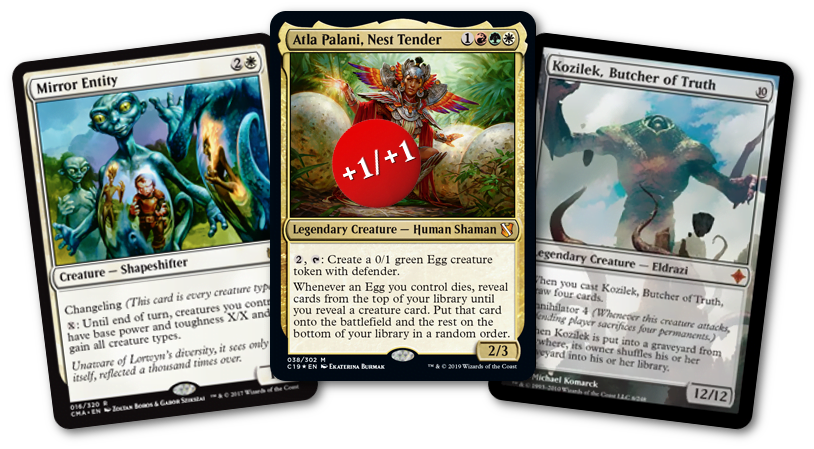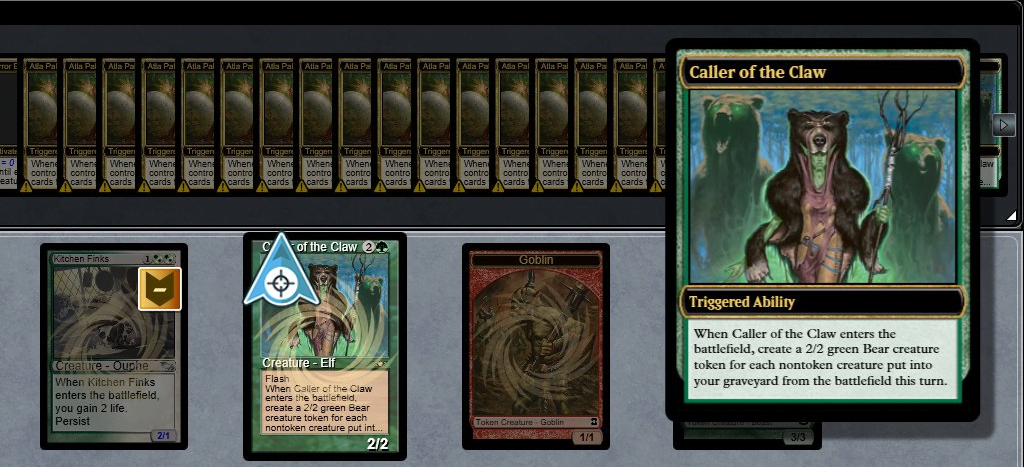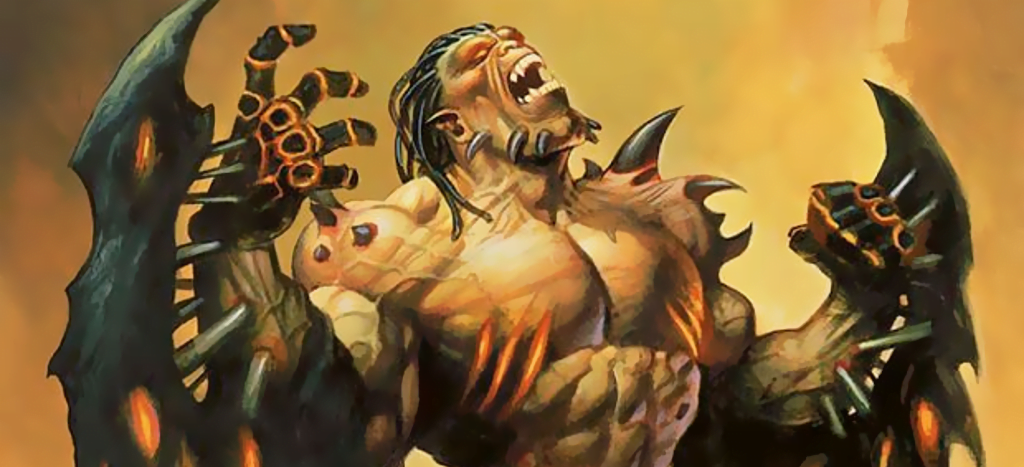This may be the most complex deck skeleton I have ever considered trying to make.
First things first, the absolute basics. Our format is Commander – in my case, 1v1 on MTGO but the principles hold for other formats. The combo is Atla Palani, Nest Tender plus Mirror Entity. If you can increase Atla’s toughness by any amount, the entity lets you cycle through every card in your deck, into play, for no mana, getting arrival triggers and death triggers. You can prevent this from decking yourself by putting Ulamog, the Infinite Gyre or Kozilek, Butcher of Truth in your deck.

What this means is that if you’re in a board state with Atla with a counter or equipment or aura on her, then can get the Mirror entity down, you kind of get to just vomit your entire deck’s collection of creatures onto the battlefield, an arbitary number of times. The idea of working out how you win from there is pretty academic – the simplest version of this loop includes a Orcish Hellraiser. That gives you an infinite number of loops and infinite damage to any Gideons then any players until everyone is dead and takes up four slots in your deck: Entity, Kozilek, a way to buff Atla, and the Hellraiser.
What makes this deck core so fun to think about though is the way that it’s made up of extremely redundant parts, and each of those parts implies other things.
First of all, you could hypothetically build this deck as a three colour control deck, with slots dedicated to protecting yourself, stalling out the game, then when you’ve wrathed and bolted and harmonized your way to the end game, just find the entity, buff Atla, then kill everyone no matter the way the board is laid out. One problem here is that this is really boring, and another is that it’s really vulnerable: Killing your Commander 2/3 times slows down the combo, and if you only have one or two ways to win the game, it’s not that hard to stop them all from working. It’s also a design that makes the Mirror Entity worse, because all the entity can do is the combo.
The more you do to make the deck about looping, though, the more complicated things get. This is obviously not ideal – you’re trying to combo out, you haven’t actually won, but now everyone has to sit back and wait because they don’t get to play while you goof around with looping piles of cards. That’s rude and not fun. There is after all, windows of time where this combo can be vulnerable-ish, so you sort of owe it to the pod to play it out.
You can go another route as well, which is build for a lot of different combo engines – the Mirror Entity works with Reivellark, for example, and you can jam in Karmic Guide and Hissing Iguanar and there’s another loop that does infinite damage, no combat step required. You can pack Lords like Deranged Hermit, a card that normally is ‘pretty good’ for putting 9 power on the table. With the Mirror Entity down, you can set X as 2, and suddenly your 9 power jumps to from 9 to 15. Just going wide with 1/1s and 2/2s with creature keywords means the entity can be a kind of overrun effect.
Now, an extra complication with this deck is not so much its combo potential or its complex interactions but just getting it to behave on mtgo and the mechanical challenge of executing it in real life. See, when you fire off this effect with Atla, the game does track the cards it reveals; and it will, when there are no creatures left in your library, reveal your entire library. Then if it has to, it will reveal your library again. And again. And again. And it will track all the cards in your library it’s revealed, and show a count of them.

It’s only a few loops before you’re revealing 500ish cards, and around that point, MTGO’s interface starts to get extremely laggy and extremely buggy. This is when the game resets to zero, turns one of your basic lands into a commander and asks you if you want to mulligan a completely different starting hand. If you want to play this deck on MTGO, you can’t rely on going too big. It’s also why I don’t want to do Hissing Iguanar style aristocrat designs here – managing three things with death triggers when twenty creatures dies brings the interface to a dead stop, and sometimes you can just tell your opponent ‘I have a loop’ and they’ll be okay with it and concede but if they don’t you’re left spending ten minutes stacking things that are sometimes three clicks each. That’s super annoying.
Bearing that in mind, what I opted to for this deck was a go-wide deck that could benefit from the Mirror Entity in a bunch of ways that amuse me while still sticking to a primary plan of evasive, aggressive, resilient threats.
Using 8×8 Theory, which I’ve gone over in the past, I knew I wanted these piles:
- Entity Combo Components and ways to protect the entity
- Creature pump for the combo
- Creatures that make tokens to go wide with the entity
- Ways to find the Entity
- Mana acceleration and fixing
- Removal for opponent’s threats
- Threats
- More Threats
I’m not going to do specific piles at this point, because this is so preferential and my list laid these cards out and then adjusted values as I needed more things (I have about 13 mana dorks, for example) but here are some notes of card synergy I came up with.
I’m also not inclined to put together a big final list, because this is complicated and I think you’ll be best off seeing how the cores work and put together your own favourite bits. This isn’t a competitive deck, it’s a hybrid aggressive/combo deck, so you’ve got to put in some total carries.
The Entity Is Everything
There are some neat cards with creature-type limited effects that all work on the Mirror Entity in this deck. Particularly, Rebels can tutor the Entity onto the battlefield, Atzocan Seer can retrieve it from the graveyard, Slivers buff it, Flamekin Harbinger and Treefolk Harbinger find it for 1 mana, the three Ixalan Forerunners all tutor it up and leave behind a not-irrelevant body, Imperial Lancer is a 1-drop double striker, and there are a few other miscellaneous interactions I tried out.

A full rebel chain isn’t worth it, but Defiant Falcon and Amrou Kithkin are both two drops that can hunt up the Entity and fit decently in a curve. Indeed, one of my favourite things you can do with the Defiant Falcon is end of turn, tutor up the entity, then untap and attack for ten with the entity turning them both into 5/5s.
That’s one of the things about the Entity’s combo potential that gets lost easily. Overrun is a great card and it costs five – for five mana out of nowhere, the Entity is only giving you one less +1/+1, and it scales up so grossly. There are numerous times I’ve been navigating in my head a way to get Atla and combo out when I realise I have four mana dorks on the table and an Entity, so just attacking for twenty-four is perfectly good enough.
It’ll be one of the reasons you practice this deck – not just because you need to make sure Kozilek shuffles your creatures into your deck before you go looking for more, not just because stacking counters can keep things alive or get rid of them when you don’t want that, but because there are a lot of times when your deck of fast starting, sprawling creatures on the field just gets there thanks to having even a modest +1/+1 to all creatures.
Double Strikers
My eventual list goes a little harder on double strikers than I thought I would, because double strike is one of those things that works well with the entity, and there are a surprising number of pretty decent 1/1 Double Strikers. Particularly, I like
But there’s room for more. The 3 mana double striker is a rich vein of interesting cards, and even as I say this, Silverblade Paladin looks like a better Swashbuckler. Double Strike is one of those reasons the Entity is so exciting, but also it works well with the creature pump that comes later.
Two and three mana is about the perfect spot for Double Strikers – and it seems a slot that’s always going to be getting better. Given how crowded two mana is in this deck (my current build doesn’t even run Qasali Pridemage, so you know I’m tight on spaces), maybe even picking up some of the 3 mana double strikers might be a really good idea because the impact of a double striker that flies may well outpace a double striker that doesn’t even if it comes out a turn earlier.
Even looking at this I’m still thinking of ways to rebuild this aspect of the deck!
Creature Buffing
My first drafts used every 1 mana ‘hexproof and some toughness’ card I could find in the colours. Then, practice taught me that Vines of Vastwood is a hell of a card to point at a Double Striker. That gave me the drive towards buffs that give any toughness (to work with Atla), more power if I can get it, and being very cheap, resulting in a list of equipment that feels like some really good draft cards, like:
- Grafted Wargear
- Trusty Machete
- Dowsing Dagger
- Sword of the Meek (which gets blown up real quick let me tell you)
- Stormrider Rig
- Manriki-Gusari
- Conqueror's Flail (didn’t get to test this, because it’s pricey)
- Runed Stalactite (really)
- Ancestral Blade
Not all of them made the cut – I ultimately just can’t resist serving for six with double striking two-drops, which pulled me more towards the aggressive cards that can be used on turn 3. But there are some cute ideas mixed in there.
Hey, did you notice that the Grafted Wargear can be shortened to Gwargear? I think Gwar would approve.

I also tried out some one-shot pump spells and there’s absolutely space for them (and hey, you can even try adding some Infectors in if that’s your deal).
- Invigorate
- Gather Courage
- Vines of Vastwood
- Selesnya Charm
- Dromoka's Command
- Blossoming Defense
- Feat of Resistance
- Assure//Assemble
- Silverflame Squire
- Mutagenic growth
- Might of the Nephilim
I also like a few lands that can get you +1/+1 counters without costing you many slots
Creature Quality
One drops aren’t just that good in a thirty life format, but I have a deep love of a whole host of cheap creatures
See, part of the thing with this deck is you don’t want to just sit around durdling around behind your combo potential. This is a deck that benefits from being jammed full of creature cards that can do stuff, and while your combo can explode on turn three (T1 dork, T2 entity, T3 Atla+gather courage or Invigorate, go infinite), there are going to be a lot of games where your time is spent finding some of those pieces, and you don’t want to be sitting there with a bunch of creature pump that’s not doing anything until you find one card.

What I prefer is to make a bunch of creatures that put on the pressure on their own, and that means delving into a rich vein of oversized two and three drop creatures. I love these creatures, especially in this colour combination, you get some absurd things when you pick up the cards that are literally just meant to attack and block and often these are cards that can be had for a cent.
- Loxodon Smiter
- Watchwolf
- Fleecemane Lion
- Isamaru, Hound of Konda
- Prowling Serpopard
- Kessig Prowler
- Dragon Hunter
- Tattermunge Maniac
- Dryad Militant (says trans rights)
- Glory-Bound Initiate (a 4/4 2 drop)
- Serra Avenger
- Orcish Hellraiser
- Exemplar Of Strength
- Voltaic Brawler
- Smuggler's Copter
- Bonecrusher Giant (what the fuck is this card)
- Hanweir Garrison
- Wayward Swordtooth
- Lovestruck Beast (can’t find haven’t tested)
- Woolly Thoctar
Some of these cards are absolute all stars of big dumb idiot that attacks and I love them so much. There’s something great about them with the one-shot pump spells sometimes too – particularly funny is when someone gets in the way of a two-colour creature when you’re packing the Might of the Nephilim. Dryad Militant becomes a 6/5, crack. I can’t tell you how happy I was to serve with a Woolly Thoctar and then jam it with a Might of the Nephilim.
Take 11, yep yep.
Picking Your Battlers
Then there’s tutors, searching for the Entity (the most important card that isn’t in your Command Zone or massively redundant). This is a space green excels at, but that’s not to say it’s the only colour contributing. Some tutors I’ve tried or considered have been:
- Chord of Calling
- Gamble
- Eladamri's Call
- Amrou Kithkin
- Defiant Falcon
- Lin Sivvi, Defiant Hero (who recovers it as well!)
- Brutalizer Exarch
- Defiant Vanguard
- Eldritch Evolution
- Fauna Shaman
- Finale of Devastation (haven’t tried, too expensive)
- Imperial Recruiter
- Hibernation's End
- Primal Command
- Recruiter of the Guard
- Sarkhan's Triumph
- Shared Summons
- Uncage The Menagerie
- Weird Harvest (Really!)
- Traverse the Ulvenwald
Some of these work better than others. This isn’t a big mana deck, so the Finale doesn’t tend to do as much as you’d want – really, that’s a card for a deck full of dorks that can just make one or two connect. Some of them are very flexible, like the Recruiters, but there isn’t as much utility using them. Uncage is pretty sweet when you can fire it off for three – a five mana play that draws you three cards is generally going to be okay, as it is. Others are just way too slow or expensive to play with.
My favourites in this list are Chord, Eldritch Evolution and Defiant Falcon – the Falcon is a cheap evasive threat, carries equipment just fine. Evolution is particularly sweet because Riftsweeper can recover it – Oh, yeah, I’m running Riftsweeper as well. It’s a paranoia thing, but getting the entity Swords to Plowshared at the worst moment just seems like it’d suck ass, so being able to recover it like that is pretty neat! And it’s a bear, so it’ll do the job if I just need someone to swing a sword.
Gamble is a really sweet card and I’ve used it to go get some odd cards (like Command Tower or Guildmage’s Forum), but it feels like a waste that I can’t use it to go get some card that’s going to be good no matter what happens. Gambling for a Adorned Pouncer is as good as I’ve got, and that doesn’t compare to Gambling for (say), Life From The Loam.
Special mention though to Traverse the Ulvenwald: I can’t get Delirium with this deck. It just doesn’t seem to happen often enough to try the card out.
And All The Rest
There’s some other stuff I found I wanted; particularly, I wanted haste granters, so that I could tap mana dorks for mana while doing Mirror Entity cycles, and to make the resulting board state immediately threatening (and just because they’re good). Mana Dorks are also really important – special shoutout to Faeburrow Elder, which is an utter fucking house. With a Mirror Entity, the Elder can serve, tap itself and become a 6/6, which is pretty sweet. There’s also Channeler Initiate, a mana creature that becomes a beatstick pretty quick, and I’m very fond of it too.
The card draw I selected was based on what I had and a pretty quick metagame on MTGO for 1v1 – which means cards like Wheel of Fortune and Tormenting Voice are more important than slow growing card draw. Special credit though goes to Skullclamp, a card that feels positively unfair with Atla pumping out card advantage 0/1s every turn.
The best Commander deck designs give you room to do your own stuff, and this one is no different. You can make it creature heavy, creature light, you can run a bunch of goofy lands, you can even jam it full of Slivers or elves or Shamans. I tried out a hatebears design, with some really strong red and white ‘fuck you for doing things’ cards, and they were lots of fun to try out, if a lot slower than this exploder.
There’s really so many choices for how you can make this deck work, and I recommend you check it out…
Just bring some notepaper.
Because this deck gets really complicated.
Oh and the name?
Well it’s what most of my decks are called on MTGO right now.